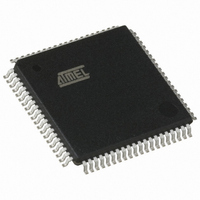AT89C5132-ROTUL Atmel, AT89C5132-ROTUL Datasheet - Page 115

AT89C5132-ROTUL
Manufacturer Part Number
AT89C5132-ROTUL
Description
IC 8051 MCU FLASH 64K USB 80TQFP
Manufacturer
Atmel
Series
AT89C513xr
Specifications of AT89C5132-ROTUL
Core Processor
C52X2
Core Size
8-Bit
Speed
20MHz
Connectivity
IDE/ATAPI, I²C, MMC, PCM, SPI, UART/USART, USB
Peripherals
I²S, POR, WDT
Number Of I /o
44
Program Memory Size
64KB (64K x 8)
Program Memory Type
FLASH
Eeprom Size
4K x 8
Ram Size
2.25K x 8
Voltage - Supply (vcc/vdd)
2.7 V ~ 3.3 V
Data Converters
A/D 2x10b
Oscillator Type
Internal
Operating Temperature
-40°C ~ 85°C
Package / Case
80-TQFP, 80-VQFP
Cpu Family
89C
Device Core
8051
Device Core Size
8b
Frequency (max)
40MHz
Interface Type
IDE/SPI/UART/USB
Total Internal Ram Size
2.25KB
# I/os (max)
44
Number Of Timers - General Purpose
2
Operating Supply Voltage (typ)
3V
Operating Supply Voltage (max)
3.3V
Operating Supply Voltage (min)
2.7V
On-chip Adc
2-chx10-bit
Instruction Set Architecture
CISC
Operating Temp Range
-40C to 85C
Operating Temperature Classification
Industrial
Mounting
Surface Mount
Pin Count
80
Package Type
TQFP
Package
80TQFP
Family Name
89C
Maximum Speed
40 MHz
Operating Supply Voltage
3 V
Data Bus Width
8 Bit
Number Of Programmable I/os
44
Number Of Timers
2
Maximum Clock Frequency
20 MHz
Data Ram Size
2304 B
Mounting Style
SMD/SMT
A/d Bit Size
10 bit
A/d Channels Available
2
Height
1.45 mm
Length
14.1 mm
Maximum Operating Temperature
+ 85 C
Minimum Operating Temperature
- 40 C
Supply Voltage (max)
3.3 V
Supply Voltage (min)
2.7 V
Width
14.1 mm
For Use With
AT89OCD-01 - USB EMULATOR FOR AT8XC51 MCU
Lead Free Status / RoHS Status
Lead free / RoHS Compliant
Available stocks
Company
Part Number
Manufacturer
Quantity
Price
18.6.2
4173E–USB–09/07
Broadcast Address
address. The don’t care Bits provide the flexibility to address one or more slaves at a time. The
following example illustrates how a given address is formed.
To address a device by its individual address, the SADEN mask byte must be 1111 1111b.
For example:
The following is an example of how to use given addresses to address different slaves:
The SADEN byte is selected so that each slave may be addressed separately.
For slave A, bit 0 (the LSB) is a don’t-care bit; for slaves B and C, bit 0 is a 1. To communicate
with slave A only, the master must send an address where bit 0 is clear (e.g. 1111 0000B).
For slave A, bit 1 is a 0; for slaves B and C, bit 1 is a don’t care bit. To communicate with slaves
A and B, but not slave C, the master must send an address with bits 0 and 1 both set (e.g.
1111 0011B).
To communicate with slaves A, B and C, the master must send an address with bit 0 set, bit 1
clear, and bit 2 clear (e.g. 1111 0001B).
A broadcast address is formed from the logical OR of the SADDR and SADEN registers with
zeros defined as don’t-care bits, e.g.:
The use of don’t-care bits provides flexibility in defining the broadcast address, however in most
applications, a broadcast address is FFh.
The following is an example of using broadcast addresses:
For slaves A and B, bit 2 is a don’t care bit; for slave C, bit 2 is set. To communicate with all of
the slaves, the master must send the address FFh.
To communicate with slaves A and B, but not slave C, the master must send the address FBh.
SADDR = 0101 0110b
SADEN = 1111 1100b
Given = 0101 01XXb
Slave A: SADDR = 1111 0001b
Slave B: SADDR = 1111 0011b
Slave C: SADDR = 1111 0011b
Slave A: SADDR = 1111 0001b
Slave B: SADDR = 1111 0011b
Slave C: SADDR = 1111 0010b
SADEN = 1111 1010b
Given = 1111 0X0Xb
SADEN = 1111 1001b
Given = 1111 0XX1b
SADEN = 1111 1101b
Given = 1111 00X1b
SADDR = 0101 0110b
SADEN = 1111 1100b
(SADDR | SADEN)=1111 111Xb
SADEN = 1111 1010b
Given = 1111 1X11b,
SADEN = 1111 1001b
Given = 1111 1X11b,
SADEN = 1111 1101b
Given = 1111 1111b,
AT89C5132
115














